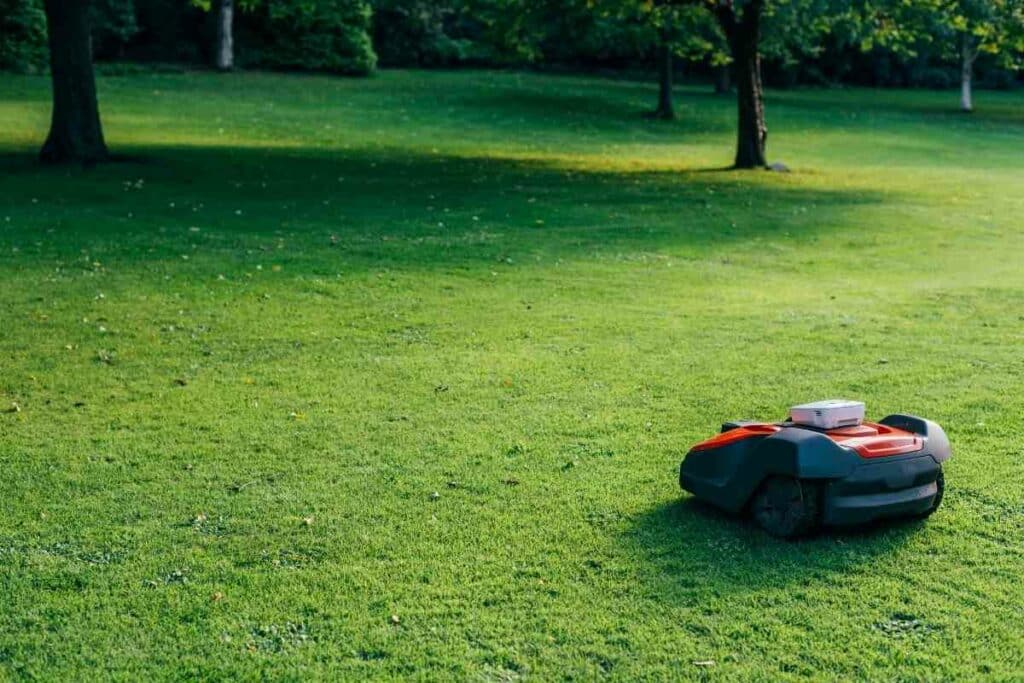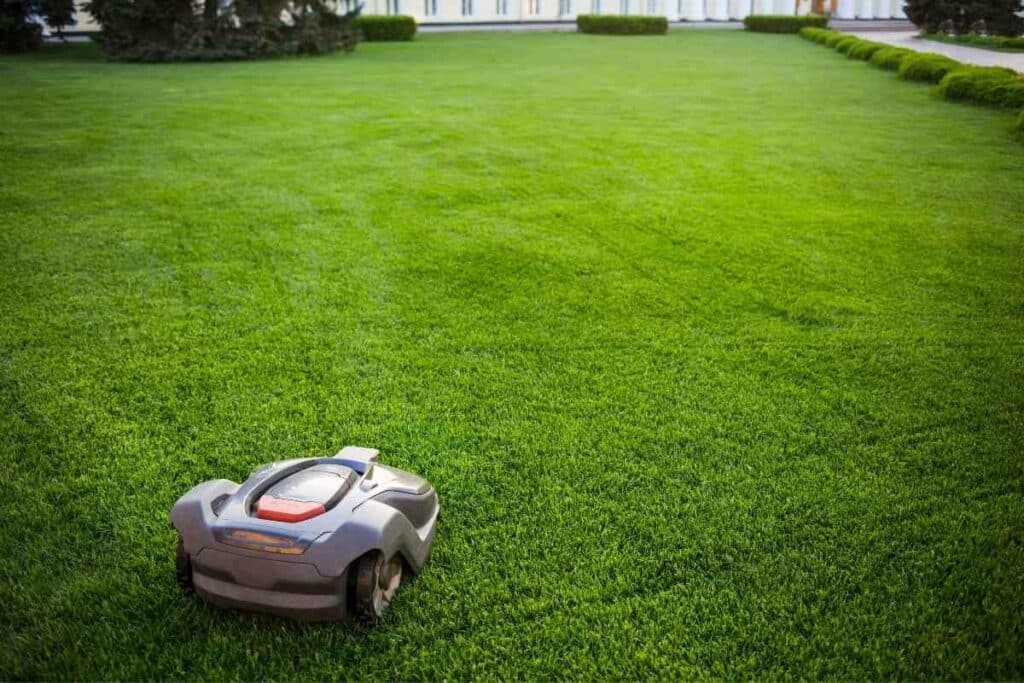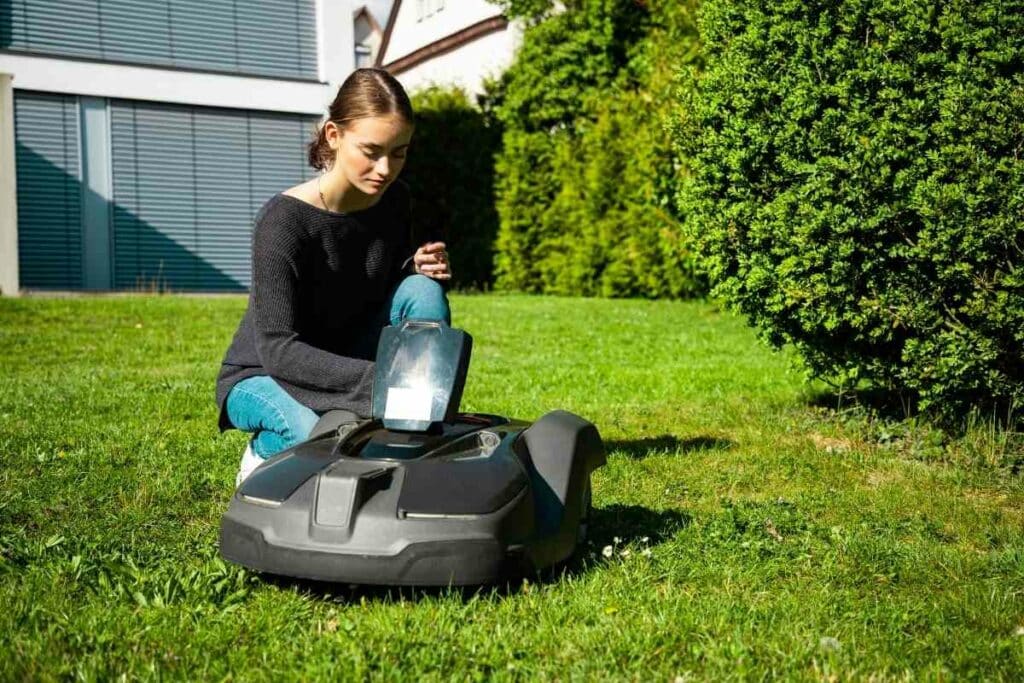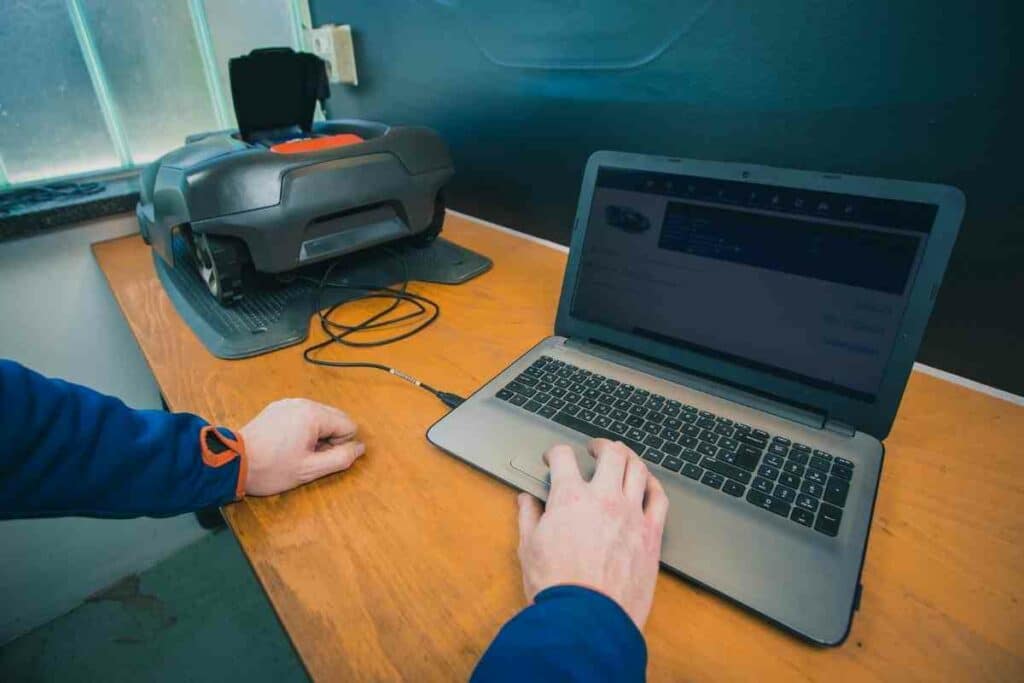If you are considering ways in which you can save the time and effort of mowing your lawn yourself, a robotic mower could be the ideal solution.
These futuristic gadgets will mow your lawn throughout the growing season, keeping it healthy and under control and leaving you free to spend more time enjoying your garden.

Because robotic mowers are yet widespread, people have lots of questions about them.
In particular, knowing how these mowers keep themselves powered can help you choose the right mower for your garden.
In This Brief Article – We will explain how battery-operated robotic mowers keep themselves charged and run through the key power specifications of a robotic mower.
Do Robotic Mowers Self-charge?
You’ll be glad to know that you won’t have to haul your new robotic mower inside every day to top up its battery. Most battery-powered robotic mowers come with a charging station that you connect to your mains power. When the robotic mower runs low on power, it will automatically return itself to the charging station to replenish its battery before resuming its mowing rounds.
Battery Power Is Key to the Performance of Robotic Mowers
Having a robot mower mow your lawn is a very different experience from the noise and fumes of a traditional push mower.
Plus all those miles of tangled power cord…
These robots use advanced technology and wireless control to take care of your lawn cord-free.
At the heart of your mower is a hard-working battery that is designed to provide clean and consistent power.

Benefits that come with a battery-powered robotic mower.
Because an autonomous lawnmower relies on battery power, it is highly convenient and has some significant benefits compared to alternative power sources:
- Cord-free: Because these robotic mowers are not on a leash, they are free to roam free and can be highly maneuverable.
- Emission-free: Battery-powered devices are free of the choking fumes and large carbon footprint that come with a petrol mower. Easier on your lungs and the environment as a more sustainable choice.
- Low-noise: If you are used to the sound of the weekend being a running lawnmower, you will be in for a surprise with robotic mowers. As they do not have a combustion engine, they run extremely quietly meaning your garden will be a haven of peace.
- Lightweight: Most robot mowers have onboard batteries that use the latest technology to be a light as possible while still delivering the power needed for excellent performance at cutting your lawn.
- Low running costs: Compared to a petrol ride-on or push mower, the running costs of a battery-powered mower are extremely low. These mowers are also programmed so the battery never becomes empty, meaning that you only have the costs of topping up the battery rather than a full charge.
- Long run-time: These mowers can mow for prolonged periods before requiring recharging. The best models will mow for an hour or more before they return to the charging station for a similar period.
A Robotic Mower Will Ensure That Its Onboard Lithium-ion Battery Stays Fully Charged
The key to the utility of these self-charging robotic mowers is the Li-ion battery that they carry.
Common in consumer electronics, lithium-ion batteries are the perfect partner for the technologies that these automatic lawn mowers used to deliver a perfectly cut lawn.
Lithium-ion batteries are rechargeable and long-lasting. They are durable and have a long cycle life.
When the mower is in use, lithium ions in the battery move from the negative end of the battery to the positive end, and the reverse takes place when the batteries are being charged.
The mower can recharge its battery over and over, because the chemical reactions involved a stable over many cycles.
This battery type is also highly portable and has an outstanding energy-to-weight ratio and high open-circuit voltage.
In Addition – These batteries have a low self-discharge rate meaning your mower will not lose a significant amount of battery power if you store your mower through the winter.
However, the quality and cost of these batteries can vary significantly because of differences in their chemistry, performance, and safety profile.
How Long Will My Robotic Mower Battery Last?
Sadly, rechargeable batteries do not last forever. Depending on the make and model of the robotic lawnmower, you can expect the battery to last between 2 and 5 years.
Over time, repeated charging cycles in lithium-ion batteries generate unwanted chemical reactions that form crystals that diminish the battery’s capacity.

You will notice that the battery becomes unable to achieve a full charge.
If it can only charge up to 75% or less, it is probably time to replace your robotic mower’s battery.
To Charge Themselves Automatically, Robot Mowers Come with a Charging Station
Without a charging station, a robotic mower is completely useless.
The robotic mower uses its complimentary charging station to self-charge and should be purchased with this essential accessory.
The charging station is the launch pad and landing strip for a robotic mower, which starts and completes all its journeys from this base.
The mower and charging station communicate wirelessly, with the charging station emitting a signal that reminds the robotic mower of its location.
Install a charging station on a flat surface, away from corners and gradients so the robotic mower can access it easily.
The charging station has an onboard transformer and a cabled connection to an indoor power outlet.
The boundary wire that demarcates the mowing area for the robot also connects to the charging point.
The mower can use the boundary wire to find its way back to the base.
The mower will automatically return to the charging station and dock to charge, with some mowers using contactless charging.
Typical Power Specifications of Robotic Mowers
When buying a robotic mower, it’s important to evaluate its power capabilities.

Though most robotic mowers for domestic use carry lithium-ion batteries, the battery’s performance must be suitable for the size and gradient of your lawn.
Here are the key specifications to look for:
- Battery energy content: This is a measure of the capacity of the battery, measured in Watt-hours (Wh). Manufacturers calculate battery energy content by multiplying the number of Amps by the battery voltage. The stored energy of the battery will differ from the amount of usable energy the battery makes available, which is usually less.
- Charging current: Lithium-ion batteries are charged at a set level, usually between 1 and 1.5 Amps to reach their final voltage. This is because they use a constant current, constant voltage (CCCV) algorithm.
- Motor output: Manufacturers measure the power of the motors of these robot mowers in watts rather than horsepower. One unit of horsepower is equivalent to 746 watts, with a typical garden mower with a shaft power property having a motor output of about 80 watts.
- Run time or working time: The mowing time of the robotic mower is an estimate and will vary according to how the mower is being used. Tough grass, uneven ground, and gradients use more energy and shorten the mowing period post-charge.
- Charging time: This is the time taken for a fully discharged battery to become fully charged. A normally functioning robotic mower will return to its charging station before the battery becomes fully discharged, and runs out of power. The repeated cycles of charging then mowing are completely automatic – you don’t have to do anything.
Brushed Vs Brushless Motors Is Another Consideration for Self-charging Robotic Mowers
The power consumption of the mower determines the length of working time you have with the mower before it requires charging.

Though the physical conditions the mower encounters will significantly affect the amount of energy it uses, you can make a big difference to battery life by choosing a robotic mower with a brushless electric motor.
What Is a Brushless Motor?
This motor design uses a permanent magnet as its rotor.
By using magnets to generate power, the action of the brushless motor is frictionless.
This means that the motor wastes less energy as heat and its performance is enhanced.
Brushless motors are a better choice for a battery-powered electric mower because they are more efficient with a higher torque to weight ratio, and have increased torque per watt of power supplied than brushed motors.
The Ultimate in Self-charging Robotic Mowers Are the New Solar Hybrid Robotic Mowers
All robotic mowers need to return to a source of mains power to charge themselves.

But progress is rapidly being made towards creating self-charging mowers that can use their outdoor exposure to their advantage.
Few People Know – Husqvarna has launched a world-first solar hybrid robotic lawnmower. Both solar energy and electricity can power this novel design that carries a lightweight, high-specification solar panel on its chassis.
The solar panel will reduce the demand on the onboard battery demands, meaning that it can work for hours using solar power on a sunny day, without needing to return to itself to the charging station.
Rounding Up
One of the great conveniences of owning a robotic lawnmower is that you don’t have to charge them as they do it themselves.
But effective power management and battery quality are essential for a robotic mower.
Evaluate these features carefully for a robotic lawn mower that delivers long-term performance.


